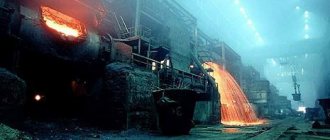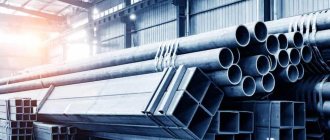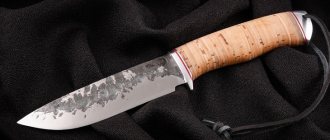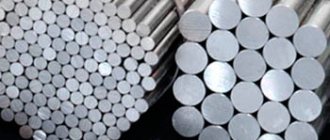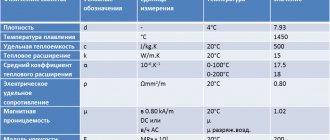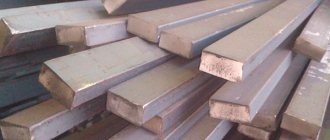The high popularity of such a material as stainless steel is explained by its unique characteristics that ordinary carbon steel alloys do not possess. Thanks to the wide variety of stainless steel grades available on the modern market, they can be selected to successfully solve various technological problems.
The appearance of stainless steel structures does not change throughout their entire service life
What is unique about stainless steels?
Stainless steel was patented in England in 1913. The author of this invention, which, without exaggeration, became the most important stage in the development of not only steel, but also other industries, is metallurgist Harry Brearley.
The addition of an element such as chromium to their chemical composition made it possible to endow ordinary steel alloys with unique characteristics and obtain corrosion-resistant steels from them.
It is chromium, which must be at least 10.5% in stainless steel alloys, that provides these materials with such characteristics as:
- exceptionally high corrosion resistance;
- very high strength;
- good weldability;
- ease of processing using cold deformation methods;
- long service life without loss of original characteristics;
- aesthetically attractive appearance of products made from alloys of this category.
Influence of alloying elements on the properties of steels
Stainless steels necessarily contain chromium and iron in their chemical composition. These elements complement each other, which is what gives these materials such unique characteristics. In particular, chromium, combining with oxygen, creates an oxide film on the surface of the stainless alloy, which becomes a reliable obstacle to corrosion processes.
In order to provide stainless steel with additional characteristics and significantly improve existing properties, alloying additives are introduced into its chemical composition - nickel, titanium, molybdenum, niobium, cobalt, etc. This alloying makes it possible to create various types of stainless steel alloys that differ from each other their characteristics and, accordingly, purpose.
We are already so accustomed to corrosion-resistant steel that we don’t even notice how much more comfortable our lives have become due to the presence of stainless steel in it.
Stainless steel contains carbon in its chemical composition, which gives it high hardness and strength. It should be noted that this chemical element is an essential component of any steel alloy and has a serious impact on its properties.
The unique characteristics of stainless steel make it possible to successfully use this metal in a variety of areas related to the operation of products and equipment in conditions of high humidity and constant exposure to aggressive environments. Stainless steels are actively used for the production of products for both industrial and household purposes. In particular, it is from this metal that cutlery and knives are most often made, elements of communications and enclosing structures, equipment parts, etc.
Classification methods
The characteristics of stainless steels are determined both by the chemical composition of the alloys and by the characteristics of their internal structure. Depending on these parameters, all steels classified as stainless steel are divided into four groups.
Ferritic (chromium)
The chemical composition of steels of this group contains chromium in a volume of 20% (which is why they are called chromium). Due to the significant chromium content, products made from such steels are able to successfully withstand even very aggressive environments. Steel alloys of this group have good magnetic characteristics.
Chemical composition and mechanical properties of ferritic steels
Large consumers of ferritic steels are enterprises of the heavy and chemical industries; elements of heating equipment are produced from stainless alloys of this type, as well as much more. Alloys of the ferritic group occupy a fairly large share of the stainless steel market and, in terms of their level of demand, are only slightly inferior to materials with an austenitic internal structure, but are much cheaper than the latter.
Austenitic
These are stainless steels, a significant proportion of the chemical composition of which (up to 33%) is chromium and nickel. Consumers prefer these alloys due to the fact that such materials are characterized by high strength and exceptional corrosion resistance.
Chemical composition and areas of application of heat-resistant austenitic stainless steels (click to enlarge)
Martensitic and ferritic-martensitic
Due to the peculiarities of the internal structure, such alloys are distinguished by the highest strength among steels. In addition, they are characterized by good wear resistance and a minimal amount of harmful impurities in their composition. It is this category that includes heat-resistant, corrosion-resistant steel, which can not only successfully withstand oxidative processes, but also be operated under conditions of constant exposure to high temperatures, without losing its original properties.
Content of chemical elements in martensitic and ferritic-martensitic steels (click to enlarge)
Combined
This includes steels with a combined internal structure: austenitic-ferritic and austenitic-martensitic. Such innovative materials optimally combine the best properties of all the above types of stainless steels.
Chemical compositions of corrosion-resistant steels of the austenitic-martensitic class
Possession of information about which group a particular grade of stainless steel belongs to allows you to optimally select alloys for solving certain technological problems.
Stainless steel grades: recommendations for selection
Stainless steel seems to be a universal material, so there should be no problems when choosing.
But in reality, everything is not so simple. There are a huge number of varieties of this material on the market, and a consistent approach and certain knowledge are required to make the right choice. In addition, stainless steel must be selected taking into account the specifics of the object and the operating conditions of the handrails.
If you need to make an informed decision, but do not consider yourself an expert, then we recommend reading the article. We will look at the main brands of stainless steel and try to provide comprehensive information about each of them.
The most popular brands and areas of their application
To choose the right stainless steel for the manufacture of products for a specific purpose, you can use special reference books that list both all grades of such material and their main characteristics. Meanwhile, in each of these groups there are the most popular brands, which are most often chosen by the consumer. Let's list them.
- 10Х17Н13М2Т and 10Х17Н13М3Т are steels that are characterized by good weldability and excellent corrosion resistance. Thanks to these properties, stainless steel alloys of these grades are successfully used for the production of products that, during their operation, are constantly exposed to high temperatures and aggressive environments. The properties of steels of these grades are formed due to the presence in their chemical composition of the following elements: chromium (16–18%), molybdenum (2–3%), nickel (12–14%), carbon (0.1%), silicon (0 .8%), copper (0.3%), sulfur (0.02%), phosphorus (0.035%), manganese (2%), titanium (0.7%). If there is a need to select stainless steels of these grades, then you should keep in mind that their foreign analogues can also be purchased on the domestic market, namely: SUS316Ti (Japan), 316Ti (USA), OCr18Ni12Mo2Ti (China), Z6CNDN17-12 (France) ).
- 08Х18Н9 and 08Х18Н10 are stainless steel alloys from which pipes of both round and any other cross-section are made. These materials are used for the production of various structures used in the mechanical engineering and chemical industries, as well as for the production of pipeline elements and furnace devices. The chemical composition of these grades of steel contains the following elements: chromium (17–19%), carbon (0.8%), titanium (0.5%), nickel (8–10%).
- 10Х23Н18 - steel of this grade is characterized by a high content of nickel (17–20%) and chromium (22–25%), as well as manganese (2%) and silicon (1%) in its composition. This combination of elements gives the alloy the required characteristics and creates an increased tendency to temper brittleness. It should be noted that the alloy of this grade belongs to stainless steels of the heat-resistant category.
- 08Х18Н10Т - a stainless alloy of this brand is characterized by high resistance to oxidation processes, as well as good weldability, and to obtain a high-quality connection using this technology, the products do not need to be preheated, and they also do not require heat treatment after welding. To improve the strength characteristics of products made from such steel, they must be hardened, as specified in the relevant regulatory document.
- 06ХН28МДТ - an alloy of this grade is optimally suited for creating welded structures that will subsequently be used in aggressive environments. The chemical composition of this steel contains the following elements: chromium (22–25%), nickel (26–29%), copper (2.5–3.5%).
- 12Х18Н10Т – products made from steel of this grade are mainly used to equip enterprises in the chemical, pulp and paper, construction, food and fuel industries. This metal is characterized by thermal resistance, good impact strength and practicality of use.
- 12Х13, 20Х13, 30Х13 and 40Х13 – stainless steel alloys of these grades are practically impossible to weld, but they also have positive properties. The latter lies in the fact that these steels do not have a tendency to temper brittleness, and their internal structure is not affected by defects, which in professional language are called flakes. Cutting and measuring tools, as well as springs and springs for various purposes are made from these grades of stainless steel.
- 08Х13, 08Х17, 08Х18Т1 are stainless steel alloys of the ferritic group, from which products are produced that do not experience shock loads during operation, as well as exposure to low temperatures.
Types of stainless steel surfaces
How to decipher the markings
Marking of stainless steels, the rules for the formation of which are stipulated by the provisions of regulatory documents, carries the following information:
- the number in first place indicates the quantitative content of such a chemical element as carbon in the alloy composition (for example, in steel grade 08Х17 carbon is contained in an amount of 0.08%, and in 40Х13 - 0.4%);
- after the letters in the marking, each of which indicates the corresponding chemical element (X - chromium, H - nickel, M - manganese), numbers are placed indicating its content in whole percentages.
An example of decoding the designation of stainless steel
In general, if we talk about the rules for marking steel alloys classified as stainless, they are practically no different from those adopted for marking steels of any other type.
Stainless steel AISI 304
A little about the designation. The basis is the classification of the American Institute of Steel and Alloys (which, in fact, in English looks like the American Iron and Steel Institute, AISI), which appeared in the 30s of the last century, due to the need to streamline the technical terminology of the metallurgical industry. Specifically, analyzing the designation of brands according to the AISI classification can tell us little. For the AISI 304 alloy, the first digit “3” indicates that it belongs to the austenitic class, and the subsequent “0” and “4” simply inform about the serial number of the steel in the entire group of austenitic class stainless steel. In a word, melancholy.
If we consider the domestic analogue of the AISI 304 brand, which according to GOST 5632-72 is 08Х18Н10, then deciphering the stainless steel grade will become a much more exciting activity. At its core, the decoding of GOST stainless steel grades is much more informative for us than the AISI classification. Briefly about what this set of letters and numbers is - 08Х18Н10. This is not “zero eight x eighteen ah ten” and not “zero eight x eighteen ah ten”, but I have heard such things from time to time. This is “zero eight ha eighteen en ten.” The marking designation according to the Russian standard uses only numbers and letters of the Russian alphabet, alternating one after another. All stainless steels are called alloyed, and the markings indicate exactly the main alloying components, but we will tell you what this word means a little later. Now let’s see how the marking and decoding of corrosion-resistant steels looks in more detail.
certificate for stainless steel AISI 304 (08Х18Н10)

